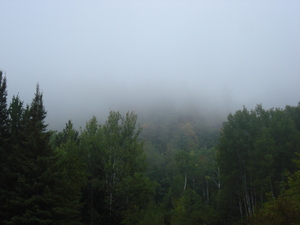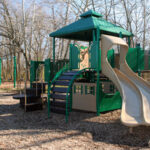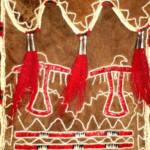For many visitors to Upper Michigan and Northern Wisconsin, seeing a live black bear in the region’s pristine wilderness is near the top of their “to-do” list. But seeing a bear is a more challenging and time-consuming goal than many tourists realize. Most bears are wary of human interaction, some prefer the nighttime hours, and many stay within thickly wooded areas.
Most black bears are not “curious” per se. They’d much rather run away from you (at speeds often exceeding 30 mph) than waltz up to take a peek inside your picnic basket and pause for a photo shoot with the kids. Furthermore, each individual bear–like each individual person–has it’s own distinct personality. This means that there are very few sure-fire ways to guarantee seeing a bear in the wild, because what attracts one black bear may repel another. That being said, there are several things you can do to increase your chances of witnessing one of these awe-inspiring mammals in its natural habitat.
First of all, time of day is not as important of a factor as many people think. A black bear’s natural instincts are to wake up around sunrise and go to sleep after dark, just like humans. However, the desire to avoid human interaction has caused many black bears to fall into nocturnal habits (meaning they’re primarily active during the night.) Whatever a bear’s sleeping pattern might be, your best chance of seeing it probably comes during the hours surrounding sunrise and sunset: this is when the bears are likely to be moving away from their dens to scavenge for food, or back to their dens to sleep.
Location is far more important than timeframe since the average black bear has a range of less than 10 miles from it’s home. Bears prefer thick forests (though not with overly-thick undergrowth.) They also tend to live in areas that have a variety of fruits and nuts for them to eat–apple trees are always a good sign. A prime bear-spotting location will also have a water source within easy striking distance. Hiking into such an area and remaining still and quiet for several hours is the best way to spot your bear, but you may also be able to see them from the comfort of your car or truck on a back-country dirt road. Even certain paved highways (such as National Forest Highway 16 which runs from Mass City, MI to Trout Creek, MI) are good starting points for would-be bear-watchers.
Your naïve preconceptions may actually help you find a black bear; if you see a forest that makes you think to yourself, “that looks like someplace a big, scary bear would live!”, you’re probably right. Semi-dense, shady, old-growth forests with lots of dead and dying trees, and dead, fallen hardwoods are perfect places for spotting Wisconsin and Michigan black bears. Many active bear habitats are almost swamp-like in appearance, or may border swamps.
If you don’t feel capable of tracking a bear, there are some methods you can use to try to make bears come to you. Because there are many laws regarding the baiting of bears in certain areas, it is not advisable for the unfamiliar tourist to use food set out on the ground as a means of attracting bears. A good alternative is to visit a sporting goods store and pick up some bear attractant scent or a wildlife call.
One excellent choice for such supplies is Settler’s Co-Op in Bruce Crossing, MI. It’s open 24 hours and has a large sporting goods section; it’s also centrally located to notorious black bear refuges like The Porcupine Mountains State Park and the Ottawa National Forest. On a recent trip to Settler’s Co-Op, I found a large bottle of concentrated bear attractant liquid for $8.00 and a simple predatory animal call for about $10.00.
If you’re going to use scents as an attractant, please be responsible and never apply the scent to yourself or your clothing. Apply the scent to trees, stumps, or rocks a safe distance away from your viewing point. While black bears are generally afraid of humans and not inclined to attack you for no reason, they are stronger and faster than you and it’s foolish to take needless risks in their domain. The results of putting bear attractant scent on yourself will not be hilarious or exciting, but possibly tragic. This is especially true of certain types of scent products which are intended to attract bears by arousing their sexuality.
There is another option for seeing black bears which is often easier, but far less authentic. Many tourists opt to seek out “dumpster bears.” These are bears that eat out of dumpsters behind businesses, and eventually become so accustomed to eating from human dumpsters (and having humans watch them dine) that they eventually begin to act almost tame. The Rainbow Motel in Silver City, MI (closed as of this writing) and the Konteka in White Pine, MI are two examples of businesses where tourists often go to sit down for a snack and try to see bears foraging through the dumpsters.
Regardless of how tame a bear may seem, it is important that you never attempt to touch or feed it. Although you may not get attacked yourself, this makes the bears less afraid of humans, sometimes to the point that they begin to associate human beings with free food. You can imagine what might then happen when a black bear who is accustomed to being fed by irresponsible tourists comes across a fisherman, hiker, or logger who doesn’t have any treats to offer…
There are some “experts” who will warn you not to venture into black bear habitat in the spring, when the bears are rearing their new cubs. But actual confirmed reports of black bears attacking humans as a means of defending their young are almost nonexistent. (This behavior is true of other sorts of bears, such as the Grizzly, and has been attributed to the black bear over the years mostly through myth and rumor.) Although a black bear may very well try to scare or intimidate you away from its offspring, it’s unlikely that it will actually attack you, even in that situation. Regardless of the fact that it’s relatively safe to observe black bears whether it’s spring, summer, or fall, it’s never a good idea to mess with the babies of a 300-pound bear. Plus it’s just not nice. A black bear cub may be asleep in its den, or hiding up in a tree only a few feet away from you without you knowing it. So if anything, it’s important to just be a little more observant and a little more respectful during a springtime excursion into black bear territory.
If, while in the woods, you do feel threatened by a black bear for some reason, don’t panic. Walk away calmly while keeping the bear in your peripheral vision. And remind yourself that black bear attacks (and even shows of aggression by black bears towards humans) are extremely rare. You shouldn’t have to feel afraid or anxious about enjoying the same wilderness that black bears call home, as long as you can be respectful of the animals and their habitat. And this type of respect is a simple matter of common sense.








